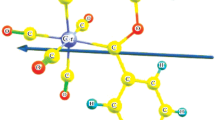Abstract
Solvent effects on the UV/vis spectra of metallopthalocyanines (MPcs) have been interpreted using the red-shift index concept (R s I). The concept connects empirically, direct, experimental, easily accessible optical spectral data, which are explained by considering the differential behavior of the solute–solvent interactions at the ground state and excited state using the spectral values of MPcs along with the derived concept, called the associated solvation energy (ASE). R s I is formulated from three fundamental parameters, which are: ground state electronic absorption spectrum, polarization red-shift and a scaling factor of MPc (N dye) in the respective solvents. The R s I is a reflection of the index value of the chromophore substituent of MPc in the solvent; thus, the concept can be used as a solvatochromic parameter to study a wide range of supramolecular and heterocyclic compounds that can be modified at their periphery or ‘handles’. Particularly, in this study, the concept has been used to rank MPc candidates by using the statistical mean performance of the solvatochromic parameters, which are red shift index, polarizability efficiency and ASE. We hereby review the solvent effects on the UV/vis spectra of substituted and unsubstituted MPcs.







Similar content being viewed by others
References
Hagan, R., Bieringer, T.: Photoaddressable polymers for optical data storage. Adv. Mater. 13, 1805–1810 (2001)
Oni, J., Westbroek, P., Nyokong, T.: Voltammetric detection of vitamin B1 at carbon paste electrodes and its detection in tablets. Electroanalysis 14, 1165–1168 (2002)
Vemkatram, N., Narayana, R.D., Giribabu, L., Rao, V.S.: Nonlinear optical and optical limiting studies of alkoxy phthalocyanine in solutions studied at 532 nm with nanosecond pulse excitation. Appl. Phys. B 91, 149–156 (2008)
Beeby, A., FitzGerald, S., Stanley, C.F.: A Photophysical study of protonated (tetra-tert-butyl phthalocyaninato) zinc. J. Chem. Soc. Perkin Trans. 2, 1978–1982 (2001)
Akpe, V., Vernet, M.C., Obirai, J.C., Brismar, H.: Understanding the photochemical pathway of in vitro target delivery of aluminium phthalocyanine: a mechanistic approach using radical reaction chemistry. ChemPlusChem 79, 671–679 (2014)
Rosenkranza, A.A., Jans, D.A., Soboley, S.A.: Targeted intracellular delivery of photosensitizers to enhance photodynamic efficiency. Immunol. Cell Biol. 78, 452–464 (2000)
Kadish, K.M., Smith, K.M., Guilard, R.: The Porphyrin Handbook: Phthalocyanines: Spectroscopic and Electrochemical Characterization, vol. 16, pp. 4, 15–4 35. Academic Press, San Diego (2003)
Wei, S., Deyin, H., Li, L., Qinghua, M.: Synthesis and properties of some novel soluble metallopthalocyanines containing the 3-trifluoromethylphenoxy moiety. Dyes Pigment 56, 1–6 (2003)
Dini, D., Guo, Y.Y., Michael, H.: Perfluorinated phthalocyanines for optical limiting: evidence for the direct correlation between substituent electron withdrawing character and the nonlinear optical effect. J. Chem. Phys. 119, 4857–4864 (2003)
Bayır, Z.A.: Synthesis and characterization of novel soluble octa-cationic phthalocyanine. Dyes Pigment 65, 235–242 (2005)
Reichardt, C.: Solvent and Solvent Effects in Organic Chemistry, 2nd edn, pp. 359–384. VCH, Weinheim (1998)
Nyokong, T.: Effects of substituents on the photochemical and photophysical properties of main group metal phthalocyanines. Coord. Chem. Rev. 251, 1707–1722 (2007)
Bayliss, N.S., McRae, E.G.: Solvent effects in organic spectra: dipole forces and the Franck–Condon principle. J. Phys. Chem. 58, 1002–1006 (1954)
Bayliss, N.S., McRae, E.G.: Solvent effects in the spectra of acetone, crotonaldehyde, nitromethane and nitrobenzene. J. Phys. Chem. 58, 1006–1011 (1954)
Amos, A.T., Burrows, B.L.: Solvent-effects on electronic spectra and excited-state dipole moments and polarizabilities. Adv. Quantum Chem. 7, 289–313 (1973)
Orozco, M., Luque, F.: Theoretical methods for the description of the solvent effect in biomolecular system. Chem. Rev. 100, 4187–4225 (2000)
Ogunsipe, A., Maree, D., Nyokong, T.: Solvent effects on the photophysical and fluorescence properties of zinc phthalocyanine derivatives. J. Mol. Struct. 650, 131–140 (2003)
Akpe, V., Brismar, H., Nyokong, T., Osadebe, P.O.: Photophysical and photochemical parameters of Octakis(benzylthio) phthalocyaninato zinc, aluminium and tin: red shift index concept in solvent effect on the ground state absorption of zinc phthalocyanine derivatives. J. Mol. Struct. 984, 1–14 (2010)
Freed, B.K., Biesecker, J., Middleton, W.J.: Spectral polarity index: a new method for determining the relative polarity of solvents. J. Fluor. Chem. 48, 63–75 (1990)
Durmus, M., Nyokong, T.: Synthesis and solvent effects on the electronic absorption and fluorescence spectral properties of substituted zinc phthalocyanines. Polyhedron 26, 2767–2776 (2007)
Chidawanyika, W., Ogunsipe, A., Nyokong, T.: Synthesis and photophysics of new phthalocyanine derivatives of zinc, cadmium and mercury. New J. Chem. 31, 377–384 (2007)
Ogunsipe, A., Nyokong, T.: Photophysical consequences of bovine serum albumin binding to non-transition metal phthalocyanine sulfonates. Photochem. Photobiol. Sci. 4, 510–516 (2005)
Ogunsipe, A., Nyokong, T.: Photophysical and photochemical studies of sulphonated non-transition metal phthalocyanines in aqueous and non-aqueous media. J. Photochem. Photobiol. A 173, 211–220 (2005)
Acknowledgments
This study was supported by the Royal Institute of Technology, KTH, Stockholm, Sweden and scholarship support was provided by the Swedish Institute and KTH.
Author information
Authors and Affiliations
Corresponding author
Rights and permissions
About this article
Cite this article
Akpe, V., Ogunsipe, A., Madu, C. et al. Red-Shift Index Concept in Solvent Effects of Chromophore-Substituted Metallophthalocyanines: A Look at the Empirical Relationship of the Macroscopic Properties of the Solute–Solvent Interactions. J Solution Chem 44, 307–326 (2015). https://doi.org/10.1007/s10953-015-0312-6
Received:
Accepted:
Published:
Issue Date:
DOI: https://doi.org/10.1007/s10953-015-0312-6




